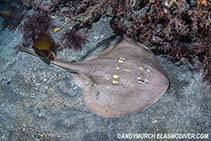| Family: |
Platyrhinidae (Fanrays) |
| Max. size: |
68 cm TL (male/unsexed); 63.9 cm TL (female) |
| Environment: |
pelagic-neritic; marine |
| Distribution: |
Northwest Pacific: southern Japan (except the Ryukyu and Ogasawara Islands), southern Korea, China, Taiwan and northern Vietnam. |
| Diagnosis: |
This species is distinguished from its congeners in having the following set of characters: a row of thorns (weakly hooked, sometimes tubercle-like) on mid-dorsum of tail; no thorns on the anterior part of scapular region; thorns on the orbital, nape and scapular regions encircled by light yellow or white pigment; dorsal surface covered with minute and some clearly larger dermal denticles (coarse to touch) (Ref. 86259). |
| Biology: |
From studies on vertebral centra, it has been suggested that females attain a greater asymptotic total length (55.58 cm TL) and grew more slowly than males (45.52 cm TL) (based on specimens from Ariake Bay, western Kyushu Island, Japan). The maximum ages observed were 5 years for males and 12 years for females. Furthermore, it was also reported that females reached sexual maturity at a greater size than males (total length at 50% sexual maturity: males, 39.3 cm; females, 42.1cm). Parturition occurred from August to November followed immediately by mating, ovulation and fertilization. Largest specimen yet recorded (USNM 51295, 68.0 cm TL, Tokyo, sex unknown) with the largest specimens examined and collected from the Hyuga Nada Sea to be 63.9 cm TL for female, and 52.5 cm TL for male; however, the species is likely to grow larger than ca. 70.0 cm TL according to local Miyazaki fishermen (Ref. 86259). |
| IUCN Red List Status: |
Vulnerable (VU); Date assessed: 02 September 2019 (A2cd) Ref. (130435)
|
| Threat to humans: |
harmless |
Source and more info: www.fishbase.org. For personal, classroom, and other internal use only. Not for publication.

